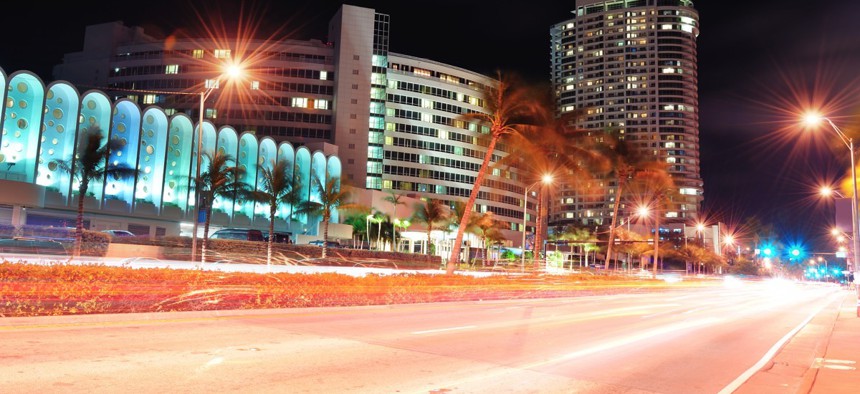For Smart Cities Like Miami, Streetlights Are Just the Beginning

South Beach Street in Miami. Songquan Deng / Shutterstock.com

Connecting state and local government leaders
Networking streetlights lays the infrastructural groundwork for a host of other smart devices.
The largest electric utility in the Sunshine State is empowering budding smart cities like Miami with networked streetlights, 500,000 of them across 35 counties in southern Florida, establishing a canopy under which to add future applications.
During its Energy Smart Florida campaign six years ago, Florida Power & Light Company became one of Silver Spring Networks’ first smart grid clients, connecting about 4.5 million electric meters—the third-largest customer base in the U.S.
Now the utility is using SSN’s platform to manage the flow of electricity between streetlights, some of the last “invisible” devices on its grid, in what the Redwood City, California-based smart grid company believes is the world’s biggest use case.
“Utilities manage around half of all U.S. streetlights, so they’re well-positioned to increase their footprint and provide more control—turning them on and off for Fourth of July fireworks, for example,” Brandon Davito, SSN vice president of smart cities and streetlights, told Route Fifty in an interview. “That is what many cities are doing: looking to make sure the foundation is set for an open standards-based network and then thinking about stacking apps on top.”
Striving to remain economically competitive, cities are viewing networked LEDs as a strategic asset—low-maintenance critical infrastructure that saves energy, lowers operational costs, improves public safety and kick-starts sustainability initiatives.
Several manufacturers build LED lamps with a standard NEMA socket on top for the plug-and-play technology to immediately join the network platform. Longer-lasting photocells measure light levels in an area and adjust light output accordingly, using the radio mesh created to talk to each other.
With unmetered streetlights, utilities charge cities a flat rate based on the wattage of the lamp, but networked LEDs have local governments demanding they be charged only for the electricity they use.
High atop streetlights, the devices are primed to reinforce existing networks or create new ones that already SSN’s European and Asian client cities are connecting other devices like air quality, noise pollution, security, and motion sensors to.
More than 50 percent of Copenhagen, Denmark’s population uses a bicycle to go to and from their workplace, so the Danish capital city added cameras under its network canopy monitoring traffic in both the vehicle and bike lanes. Now bicycle commuters can be greenlighted in a way that they never have to stop at intersections.
Light levels can be increased at night to improve public safety or when a set noise level is reached to disperse crowds after a sporting event.
Glasgow, Scotland, added smog sensors to its network that feed into the local government’s open data initiative, while in Bristol, United Kingdom, a public-private consortium has made the city’s university a testbed for smart city products on top of the existing network platform. The new model for innovation is creating jobs, though Miami isn’t at that stage yet.
“Florida Power & Light is thinking expansively about becoming a more relevant and better steward of critical infrastructure,” Davito said. “It wants to deliver services at a lower cost.”
Dave Nyczepir is a News Editor for Government Executive’s Route Fifty.

NEXT STORY: Wildfires Burning Through Cash as Fast as Forest; Shell Oil Quits Arctic Seas





